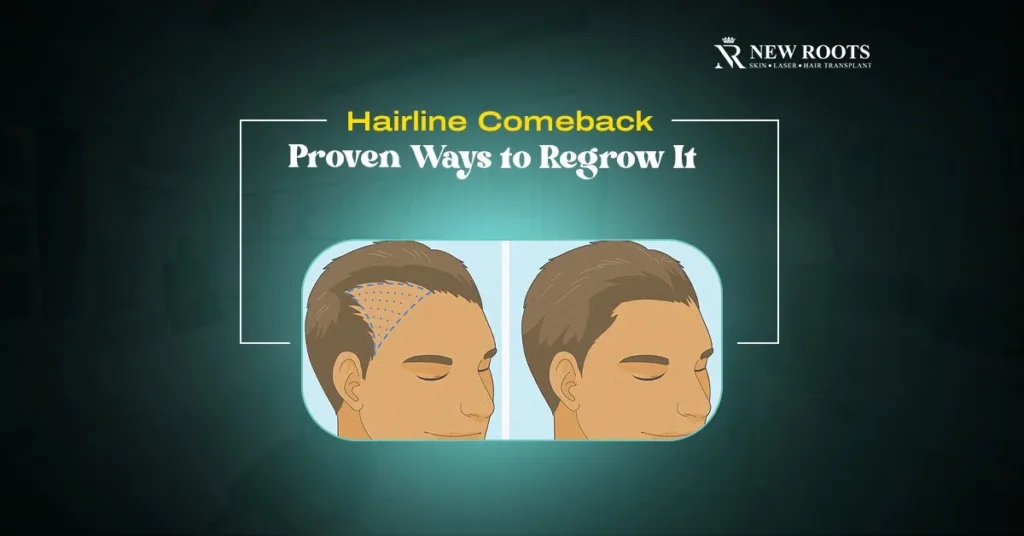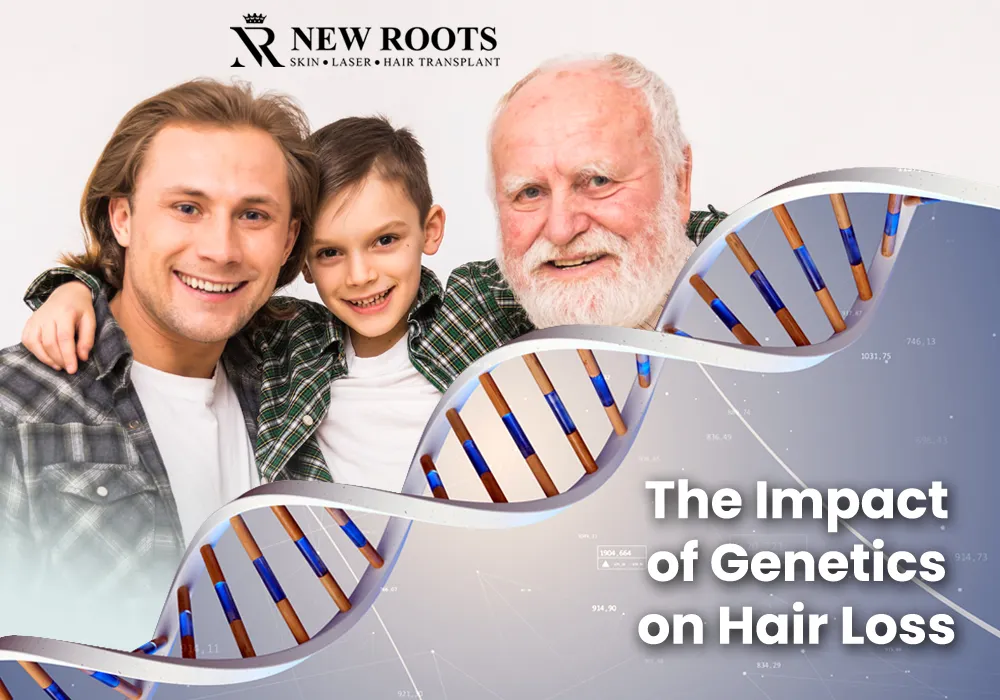It would help everybody, especially those facing the problem of bad hairlines, to know how to regrow hairlines effectively and restore confidence.
Male baldness can be bothersome as it robs you of your hairline; thus, a receding hairline is undesirable. Understanding how to regrow hairline naturally or through clinical procedures can make a significant difference.
This article is a review of the causes of hair loss, options for hair regrowth, and various treatment and management strategies.
It offers valuable insights and practical solutions, which may interest groups in India who are looking for long-term results.
Introduction
The beginnings of the process of learning how to regrow hairline involve, therefore, understanding what it means to have a receding hairline in one’s life.
The several phases of this problem can be provoked by various factors, ranging from hormonal shifts, age, or heredity.
With the right treatments and lifestyle changes, hair loss can be controlled or even reversed; thus, hair health is important.
Table of Contents
Understanding Hair Loss Causes
Balding is normally a multifactorial phenomenon that depends on a number of factors. It is important to know that these are the causes when one is researching how to regrow hairline.
Hormonal Changes
This section placed a significant emphasis on the issue of hair thinning, in which hormonal factors are considered with special stress on the hormone known as DHT, or dihydrotestosterone.
DHT is made up of testosterone and can stick to hair follicles, resulting in shrinking and loss of hair.
This hormonal imbalance is specifically disadvantageous for those bearing the hereditary factors of androgenetic alopecia.
Aging
Another risk factor for hair loss is aging. With increased age, the growth rate gradually reduces, and therefore, hair turns thinner and less compact.
Further, there are various stages of the hair cycle where new hairs grow; some phases stop the production of hair, while others are the shedding stages, which might cause complications with time.
Family History
It was also found that family history was a good predictor of the extent of hair loss a man is likely to experience.
If the parents or grandparents suffered from loss of hair, then it could well be that people inherit the same condition that leads to the thinning of the hairline.
Stress and Lifestyle Choices
They also found that both physical and emotional pressure harm hair.
The adoption of a high level of stress causes telogen effluvium, which is a condition where hair sheds in an undue time.
A person’s choice of diet and exercise, merely to mention a few, contribute greatly to one’s health and, therefore, hair.
Illness and Medications
One can cause hair loss through various diseases. Some diseases that cause hair loss of hairloss include different ailments that are treated with different medications.
Knowing that is where it can be advantageous to understand these potential triggers while browsing over how to regrow hairline.
Stages of Hair Loss
Understanding hair loss in stages can help some individuals understand their particular situation and can help them select proper treatments for their hair loss problem.

Early Stages
Usually, in the initial levels, hair withdrawal may occur at the site of the temple or crown.
It is often that a slight change in hair density is not noticeable immediately.
It is at this stage that he or she needs some intervention so that an efficient management plan may be formulated.
Progressive Stages
In its advanced stage, hair loss may cause someone to have a further backward hairline than before.
At this stage, it is essential to consult with a specialist in the search for treatments that will help overcome hair loss.
Some of the best and probably the most natural ways of treating baldness to encourage hair regrowth include;
Approximately, various remedies are available for individuals who want to know how to regrow hairline. Such options as medical, surgical, and natural options are available.
Minoxidil
Minoxidil is another topical product of treatment that is popular due to its importance in growing hair.
It enhances the circulation of blood down the brain as well as rejuvenates the hair follicles and is thus preferred by those people with balding hair.
Finasteride
It is in the class of oral medications that are used in the treatment of hair loss by blocking the formation of DHT.
This appears most useful for men affected by androgenetic alopecia, though it has been demonstrated effective in increasing both thickness and density.
Hair Transplants
For people who have reached the third and fourth stages of baldness, a hair transplant is a plausible solution.
Here, there is the movement of hair follicles that are healthy to the bald areas, so that there may be an improved hairline.
Natural Treatments
People tend to try out natural remedies alongside traditional ones if they want drastic results.
Teas, natural products, and vitamins have the potential to improve hair health, although some of them are not scientifically proven.
Some ingredients, such as rosemary oil and saw palmetto, have been found to aid hair regrowth.
Hair Care Tips for Maintaining One's Health
Besides treatments, good management of hair is crucial so that loss of hair can be prevented, especially for those with thinning hair.
Diet and Nutrition
Healthy food containing all the necessary nutrients is necessary for the body and for strengthening healthy hair. Key vitamins and minerals include:
Vitamin A: supports cell growth.
Vitamin C: Promotes collagen production.
Zinc stimulates hair tissue formation and growth as well as promotes hair strength, health, and longevity.
Iron: Helps hair not to fall off, or a small amount of hair is removed.
The addition of such foods as green veggies, nuts, fatty fish, and fruits can enhance a diet and improve hair growth.
Hairstyles to Minimize Damage
By understanding which hairstyle choices least affect follicles, one must avoid those styles that can harm hair.
Specific hair extension techniques exert a considerable amount of tension on hair strands and roots when performing certain hairstyles.
This stress can lead to another potent ailment known as traction alopecia, which is caused by continued tension on the hair follicles to result in hair loss.
Loose Hairstyles
Wearing loose hairstyles like a loose ponytail, braid-up, or loose buns is less likely to cause traction alopecia.
Some of these styles enable people to be active and in motion, and therefore exert less stress on the hair strands.
Also, wearing hair down or not tying it up with tight elastic bands or clips fosters a hair environment that appreciates the follicle growth pattern.
Variety in Styling
It is also useful to incorporate different styles of hair. Switching between the 2 for a day means that one particular method does not place stress on the hair.
For instance, hair needs to be allowed to relax, including from the tension headaches that might be caused by holding it up and away from the head, to grow healthy.
Protective Styles
Besides, loose styles of hairdressing may protect the ends of the hair from damage and the impact of environmental factors.
It may include styles such as twists, braids, or protective hairstyles where the hair is kept off the head and with less contact with surfaces like pillows and clothing.
Stress Reduction Strategies
The relation between stress and hair effects is being recognized in dermatology at present.
Different forms of baldness may result from stress; they include telogen effluvium, which is hair shedding due to stress.
Hence, the management of stress, or the lack thereof, is very important to anyone using interventions to improve their hair growth.
Mindfulness and Meditation
Habits that are now more popular, like mindfulness or deep breathing exercises, aim at bringing individuals to a state that prevents them from paying attention to stressors that might lead to anxiety in general.
These techniques can help one relax, and this will have an effect on bodily functions such as hair growth.
Yoga and Bodily Activity
The practice of yoga, which is truly exercising or movement, now not only reduces strain but also stimulates blood to move properly from the top down to the scalp.
Higher circulation in the blood brings nutrients as well as oxygen to the hair bulb, resulting in better hair growth.
The endorphins, also called the body’s natural ‘feel-good’ chemicals, are also released throughout exercise and help decrease stress levels.
Regular Physical Activity
Exercising often can help break the stress; thus, exercising can be a natural stress-relieving activity.
No matter if it is aerobic exercise, walking, or dancing, the cortisol, the hormone of stress level, is regulated by physical activity.
Reducing cortisol levels can be an advantage for hair since cortisol causes hair thinning and loss.
In conclusion, observing suitable hairdos together with proper management of stress can go a long way toward contributing to hair health and taking proper care to avoid damage.
It is possible to help people regrow their hair by paying attention to hairstyles that may harm hair and by practicing stress reduction.
Expert Recommendations and Advice
The doctor or dermatologist is the best person to turn to when developing a hairline regrowth plan, as a medical practitioner will appreciate all the measures that need to be taken to ensure that growth begins. Professionals can provide insights into:
Hair loss: What particular factors are associated with it?
Tailored treatment options.
Keeping track to monitor the level of achievement for better management in the future.
Conclusion
Therefore, to regain hairline, one needs to recognize the causes and phases of baldness, discover treatments including minoxidil and finasteride, and seek comprehensive liturgical reform and medical advice.
By so doing, one is able to attempt to regain his/her self-esteem and healthy, full hair.
Regardless of its medical approaches or natural remedies, the many-faceted manner may result in the achievement of knowing how to regrow hairline.
Data Table Related to Hair Loss Management
| Treatment Method | Description | Pros | Cons |
| Minoxidil | Topical treatment that promotes hair growth | Non-invasive, easy to use | Requires ongoing use |
| Finasteride | Oral medication that inhibits DHT | Effective for male pattern baldness | Possible side effects |
| Hair Transplant | Surgical procedure for hair restoration | Permanent results | Higher cost, invasive |
Q&A ASK
Minoxidil and finasteride are medical remedies that have been shown to promote hair growth and prevent hormone-induced hair loss, which might be powerful in the treatment of a receding hairline.
Yes, there is a need to make certain that we’ve taken ok nutrients and minerals, collectively with ok proteins, to allow the hair to grow healthy. A weight loss plan rich in precious nutrients, which includes iron, omega-three fatty acids, and nutrients A, C, and E, allows scalp follicle health and, therefore, improves hair.
Hormonal factors, in particular an upward thrust in the DHT hormone levels, bring about the miniaturization of hair follicles, causing the hairline to recede. Those hair loss situations, together with androgenetic alopecia, are substantially influenced by genetic as well as hormonal factors concerning the hair manufacturing cycle.
Essential oils, saw palmetto, and other natural supplements are known to enhance hair growth through scalp oxygenation and feeding follicles needful nutrients; apart from that, vitamins are known to effectively feed hair follicles, which in turn promotes hair regrowth. These, however, may augment the main type of treatment to achieve even better outcomes.
Hair loss occurs when stress dictates the hair follicles to shut down, or rather, enter a resting phase. Mandatory stress control through exercises and proper breathing decreases hair loss and thus promotes healthy hair regrowth.
Using proper hairstyles will go a long way in preventing further hair damage. To minimize the development of traction alopecia-free and loose hairstyles, do not pull on hair follicles. Styling hair too tightly should be avoided in these cases, since it would protect the hair’s health and allow for an enhanced growth rate.
Seek advice from a different doctor if you notice you are losing hair significantly or if normal remedies don’t work. In addition to getting a dermatologist to diagnose the root causes of hair loss, he or she can also prescribe necessary treatment and assess the regular progress of your hair regrowth.






